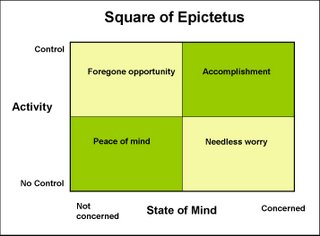Over the holidays I read
Presence: An Exploration of Profound Change in People, Organizations, and Society by Senge, Scharmer, Jaworksi, and Flowers. I enjoyed Senge's
The Fifth Discipline and have since my first reading believed that systems thinking Senge-style (a derivative of Forrester style) is a useful tool to help bridge qual-quant divide in organizational theory and analysis. I was chagrined, therefore, when I dug into
Presence and found it methodologically vacuous, full of new era overstatement, reliant on new-age mumbo jumbo, .
The book is the anecdotal account of a year and a half conversation among the authors about changes taking place in organizations in response to the rapid and global pace we witness today. The meetings take place in a bunch of swell places around the globe and the authors are earnest about finding answers to the pressing problems of organizations today, but in the end the result seems to be, drum roll please, an amalgam of what the authors believed before they started talking to one another.
This is not to say that there is nothing interesting here. The book is a not unenjoyable read with engaging stories about personal and organizational transformation. And there is interesting speculation, extension, and integration of the authors' theories. But the custom of late among organizational theorists has been to build or confirm theories in response to long-term data collection efforts. This is not a data-driven book, except in the loosest anecdotal, quasi-historical sense.
OK, fine. That a bunch of organizational theorists have written a book of speculative theory is a not a news flash, but is the theory interesting, provocative, insightful, or otherwise useful. The authors are largely concerned that the decomposition inherent in the solution of any complex problem prevents sufficient holistic thought to solve the problem well. To counter this the authors propose the U Movement, a series of seven steps to step back and be more integrative and creative about organizational problem solving. The seven steps are as follows:
- Suspending
- Redirecting
- Letting go
- Letting come
- Crystallizing
- Prototyping
- Institutionalizing
(Don't seven steps constitute a decidely unholistic decomposition of a process; can't the authors be more integrative about their learning architecture? But I digress.). The steps seem to map fairly nicely to
Wallas's earlier (1926)
Art of Thought or
Osborne's pioneering work on brainstorming going back to 1939, and the work is more concerned about how to institute such thinking in large-scale organizations as opposed to earlier creativity theorists who were more concerned with individuals or small groups. Yet there isn't anything here that seems compellingly interesting or provocative.
Moreover, to read the book one must put up with a fair amount of new-age mumbo jumbo and Western thought and institution bashing. For example, the rationale for being in the moment (to presence) is drawn from Zen and other Eastern traditions. This is fine (and certainly not new), but the authors go on and bash Western governments, institutions, and corporations for not being in the moment and sufficiently holistic. If only they were all more Eastern in their thinking, the world would be closer to the authors' utopian ideals. This is an easy game to play, because all global institutions today (including those in the East) are decidely Western in their decomposition, organization, management, and operation. Of course, this is because Western thought and culture have been decidely successful (have won the evolutionary struggle) in creating new knowledge and using it, going back at least as far as Bacon.
Of course, the jig is up once one understands what the authors want to do with their theories. Not only are they interested in improving large global organizations that are forming everywhere. Their Global Leadership Initiative, seeks to focus on "critical issues like AIDS, water, malnutrition, sustatinable food production, and climate change--over the next five years." How? "By simultaneously engaging leaders from corporations, government, and civil society, GLIS is dedicated to building leadership capacity while producing concrete results."
I see. Leaders from despotic organizations like the UN and corrupt third-world countries will hold hands and sing Kumbaya with Senge and company, do a bunch of
presencing, and solve all the remaining intractable problems of our world. That's a nice half-decade's work for an unproven methodology unsupported by data.
The larger problem here is that Forrester's leading disciple learned the wrong lessons of the master's work. The hope in the 60s and 70s that Systems Thinking I would lead to our ability to model organizations universally using computer simulation, but the failure of modeling efforts by the
Club of Rome and others largely discredited such efforts. In
Presence the tools have changed, but the utopian goals remain operative. A little humility in the face of such failure would certainly be in order but is not in evidence. As a result, it is hard to recommend
Presence as a serious contribution to the organizational literature.

